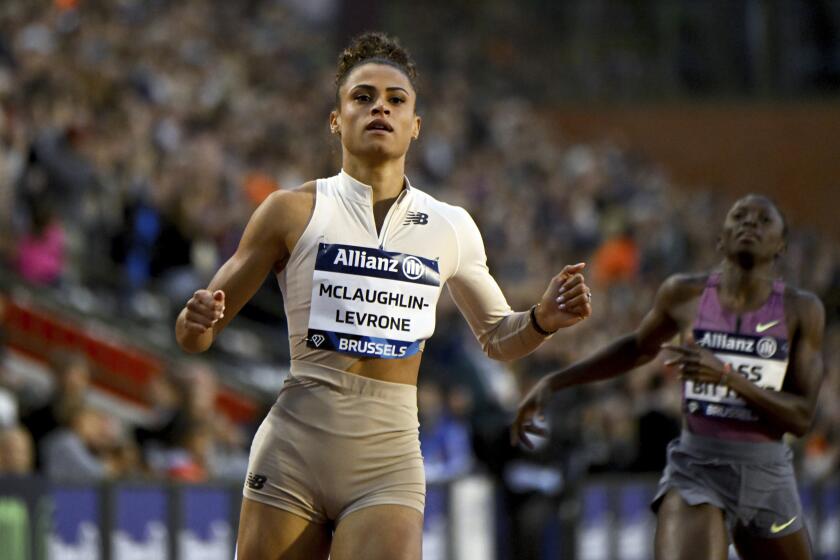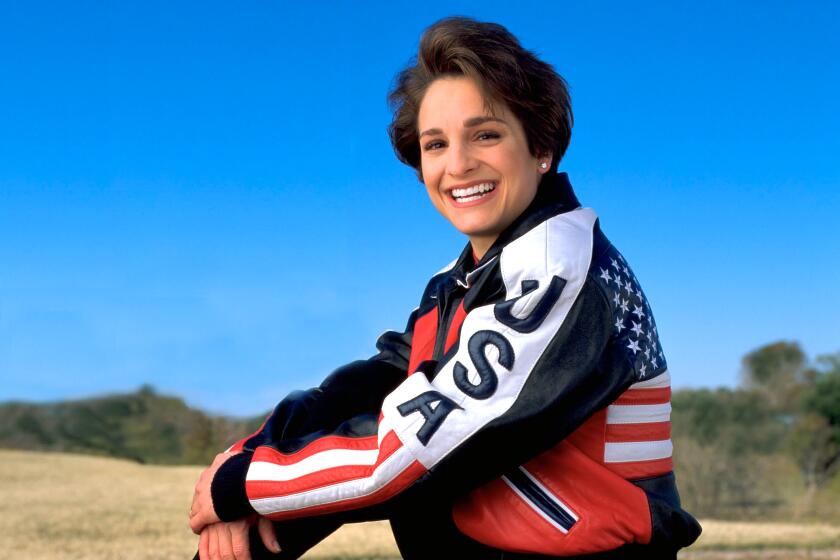WORLD SPORTS SCENE / RANDY HARVEY : Golf in the Games? Too Many Hazards
- Share via
Golf in the kingdom, the Olympics? It seemed like a good idea to Billy Payne last October, when he announced a proposal to hold men’s and women’s tournaments on the hallowed grounds of Augusta National as part of the 1996 Summer Olympics.
Not only did Payne, president of the Atlanta Committee for the Olympic Games, want it, but so did International Olympic Committee President Juan Antonio Samaranch.
Or so Payne was led to believe as he eagerly became the point man in a campaign that looked like a gimme.
Before it was over four months later, Payne had been bruised in battles with Olympic traditionalists, who believed that the proposal was inspired more by the potential for commerce than competition; Olympic pragmatists, who argued that too many sports and athletes already are included in the Games; and civil rights activists, who criticized Augusta National for the absence of racial and sexual diversity among its members.
Atlanta’s City Council passed a non-binding resolution in November in opposition because of alleged discrimination at Augusta, and the city’s mayor, Maynard Jackson, wrote a letter to the IOC emphasizing the positives of Atlanta’s golf courses.
As if those opponents were not formidable enough, U.S. television networks let the IOC know that the inclusion of golf would not enhance their bids for the rights to the ’96 Games because the sport would be too unwieldy and expensive to fit into their traditional Olympic programming.
Payne fought on with the encouragement of two leading U.S. Olympic Committee officials, executive director Harvey Schiller and President LeRoy Walker, although it is still not clear whether the USOC ever had an official position.
But it was over when Samaranch decided that he wanted to be no closer than a John Daly drive to the controversy. One wonders now whether the IOC president ever really had his heart in it or was just, as is his wont, floating an idea.
When Samaranch told an Italian newspaper two weeks ago that golf had little chance of approval, Payne realized he had been abandoned. He released a statement the next day to announce that the proposal would be withdrawn.
It is just as well. The azaleas do not bloom in the summer at Augusta.
The USOC is anticipating a lively debate during next weekend’s board of directors meeting at Phoenix. The subject is whether the United States should continue to enter full contingents of athletes to the Winter and Summer Olympics or should send only athletes who are deemed capable of competing on a world-class level.
One side will use as the basis of its argument the teachings of the founder of the Modern Olympic movement, Baron Pierre de Coubertin, who said that glory comes not from winning but from participating, while the other side will argue that the USOC spends too much money to send athletes who are just glad to be there. “Olympic tourists,” the former East Germans called them.
German newspapers are reporting that the Stasi, the secret police of the former East Germany, abducted East German athletes suspected of wanting to defect to the West during competitions in West Germany, including the 1972 Summer Olympics at Munich and 1974 World Cup of soccer, by drugging them, bounding them in the trunks of cars and transporting them back across the border.
In an incident with more tragic consequences, Lutz Eigendorf, an East German soccer player who defected to West Germany, was killed in a mysterious automobile accident in 1983.
Berlin prosecutors now have concluded from reading detailed Stasi documents that the car was tampered with so that it would crash and are preparing to go to trial next month against two former Stasi agents.
Also on the docket in the German courts is author Brigette Berendonk’s slander suit against long jumper Heike Drechsler. After Berendonk’s 1991 book, “Doping Dockumente,” accused more than 250 East German athletes, including Drechsler, of enhancing their performances through the use of illegal substances, Drechsler called her a liar. Berendonk is a former East German discus thrower.
Where there is sports news in Germany, there is drug news. A former East German hammer thrower, Detlef Gerstenberg, died recently at age 35. His father contends that his son died from cancer of the liver and pancreas resulting from the massive amounts of anabolic steroids he ingested while competing for East Germany. And before a meet last week at Berlin, Canadian Ben Johnson said in a television interview that “all top athletes still take anabolic steroids.”
More drugs: Prince Alexandre de Merode of Belgium, chairman of the IOC’s medical commission, wrote in a recent commentary for the Belgian Olympic Committee’s official publication, News Olympics, that 10% of the 9,366 athletes who competed in the 1992 Summer Games at Barcelona were, based on their steroid profiles, regular drug users. But only five athletes failed drug tests. Steroid profiles have not been authorized as a means for detecting illegal substances.
On a more upbeat note for Drechsler, she was named the Track & Field News women’s athlete of the year for her 1992 season, which included an Olympic gold medal and 16 consecutive meets with jumps of more than 22 feet 11 3/4 inches. Jackie Joyner-Kersee, who finished third to Drechsler in the long jump and won the heptathlon in the Olympics, was fourth in the rankings, the best for an American. Her training partner at UCLA, Olympic 100 meter champion Gail Devers, was fifth.
Note to Al Franken, promoter of the Feb. 20 Sunkist Invitational at the Sports Arena: Increasingly popular at European indoor track and field meets are musical high jump competitions. Olympic champion Heike Henkel of Germany recently won a competition while accompanied by Bobby Brown’s “Partytrain.”
Al Joyner, triple jump champion in the 1984 Summer Olympics and also a highly-ranked hurdler at one point, has turned to the decathlon. He will compete against two of the 10-eventer’s best athletes, world record-holder Dan O’Brien and Olympic champion Robert Zmelik of the Czech Republic, in a three-event competition at the Sunkist. . . . Los Angeles and Beijing appear to be the two finalists to stage the proposed duels on May 29 for HBO between Carl Lewis and Mike Powell in the long jump and Lewis and Linford Christie in the 100.
The most intriguing figure skating rumor is that Kristi Yamaguchi, 1992 Olympic gold medalist in women’s singles, will return in 1994 in pairs. U.S. Figure Skating Assn. officials do not put much credence in that one, but they say they are convinced that Yamaguchi is giving more serious thought than before to returning in singles.
On the negligible difference in her life since transferring operations from Moscow to Lake Placid, N.Y., respected ice dancing coach Natalia Dubova said: “I go to the rink and stay there all day, and when I leave it’s cold and dark.”
More to Read
Go beyond the scoreboard
Get the latest on L.A.'s teams in the daily Sports Report newsletter.
You may occasionally receive promotional content from the Los Angeles Times.






